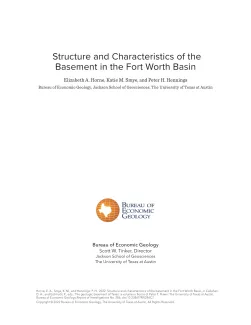
Publication Details
Get the Publication
$8.00
Abstract/Description:
The Fort Worth Basin of north-central Texas is a prolific petroleum basin that is increasingly seismically active, with over 125 earthquakes of magnitude Mw ≥2.5 since 2006, impacting the Dallas–Fort Worth metropolitan area and surrounding communities. These earthquakes have been attributed to increased pore fluid pressure from wastewater injection and from cross-fault pore pressure imbalance caused by injection and production. Understanding the structural and compositional characteristics of basement rocks that may control aspects of earthquake-prone faults is vital to quantifying known hazards. Here we provide a synthesis of recent work completed to characterize the structure of the crystalline basement. We also characterize the suite of lithologies and document compositional changes of the uppermost crystalline basement and basement–sediment interface through stratigraphic and petrophysical analyses of logged basement-penetrating wells. The geologic history, composition, and structural architecture of the Fort Worth Basin are not unique; therefore, the characteristics of the basement and variables that have impacts on seismic hazard can be applied more broadly.
Our results show that the crystalline basement in the Fort Worth Basin is dominantly granitic in composition and that basement rocks are frequently found to be altered. Evidence of prolonged subaerial exposure is observed at the basement–sediment interface in the form of increased porosity and the presence of hematite. Paleotopographic variation of the basement surface is evidenced by the presence of granite wash that is more than 60 m (200 ft) thick in some paleolows. Strata overlying basement in the Fort Worth Basin vary from west to east, with siliciclastic lithologies proximal to the Cambrian shoreline in the west, transitioning basinward to carbonate lithologies in the structurally deepest part of the basin to the east.
The crystalline basement and overlying lower Paleozoic strata are deformed by northeast-trending normal faults, which create a series of elongate horst and graben structures. Deformation ranges from isolated faults to linked and crosscutting relay systems, with segments ranging in length from 0.5 to 80 km (~0.3 to 50 mi). Faults that have recently become seismogenic are generally less than 10 km (~6.2 mi) long and exhibit over 50 meters (~164 ft) of dip-slip, vertical displacement.